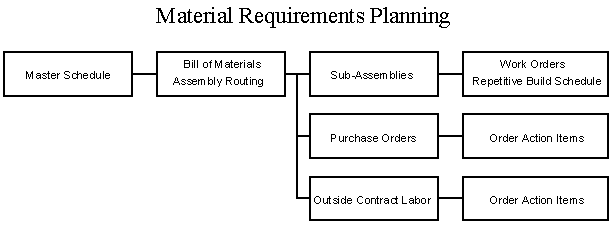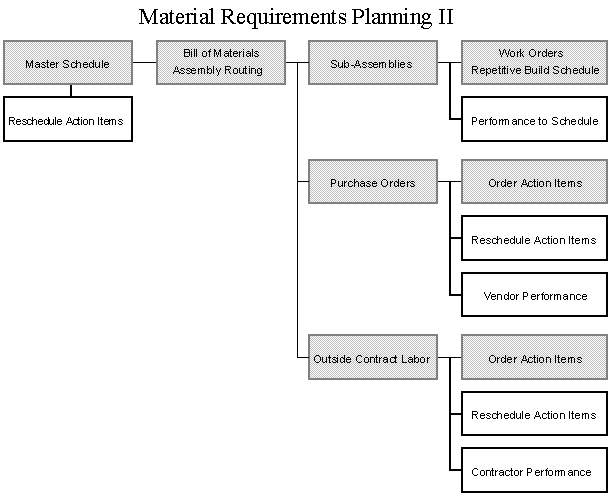
Material Requirements Planning, or M.R.P., has been officially around since
the 1960's, with the advent of the use of computers in the manufacturing
environment, though the basic principles involved in M.R.P. are an integral
part of the manufacturing process itself. However, by defining what 'M.R.P.'
is, companies and software vendors are able to adapt a standardized set of
methods by which they can schedule delivery of raw materials against the
manfacturing schedule, thus keeping their assembly lines moving while at the
same time minimizing the amount of inventory on-hand.
The ideal adaptation of the M.R.P. process has, in the past, been considered to
be a 'just in time' scenario, when raw materials arrive just as they are required
on the assembly line. Obviously, a system like this has the potential of being
thrown 'out of balance' by even the slightest problems; therefore, manufacturers
build in 'safety stock' or 'lead time' factors to prevent material shortages from
ever causing a 'line stop'. But safety stock and long lead times increase on-hand
inventory, requiring larger warehouses to store raw materials, or even work in
process, with no immediate benefit. Plus, it ties up the company's liquid capital
in non-liquid inventory, which typically depreciates, gets damaged, spoils, and/or
becomes obsolete within a relatively short period of time.
Obviously, there is a 'happy medium' somewhere in between a true 'just in time'
system, where a single late or missing delivery can have drastic consequences,
and a 'just in case' system, where piece part inventories 'turn' slowly, and often
become wasted as obsolete inventory or spoilage. Somehow we must find the best
inventory position, where the potential for material shortages is well-balanced with
the need to minimize on-hand inventories, and minimize lead times. Finding this
balance point, however, has never been a traditional component in an M.R.P. system,
or even an 'M.R.P. II' system.
Using Bandwidth Management
it is possible to establish such a balance, between a minimum inventory on-hand and
a consistently operating assembly line; therefore, we at S.F.T., Inc. propose
to define the requirements for an 'M.R.P. III' system, which (among other things)
includes the principles of Bandwidth Management as an integral component of
the process, as well as a 'Whole Business Planning' feedback loop to minimize the
impact of an improper demand forecast on obsolete and excess inventory, plant capacity,
and customer lead times.

M.R.P. began as a relatively simple, yet important analysis of manufacturing processes
and production schedules, combined with bills of material and/or resources, to
predict what the requirements would be for various components and/or manufacturing
processes in order to meet the current master schedule. In addition, M.R.P. applies
component and process lead times to these requirements, along with various other
"modifiers" (economic order quantities, safety stock, shrink factors, and
so on) to generate recommended build schedules for non-master scheduled assemblies,
and recommended purchasing orders for components. Existing schedules are not
modified by a 'standard M.R.P.' process, though reports that make recommendations
to re-schedule or cancel existing build schedules or purchase orders may be included
in a 'standard M.R.P.' system. In essence, the 'M.R.P.' system merely performs an
analysis of existing conditions, and reports back to you what the requirements are,
and optionally recommends changes to existing purchase and production schedules to
meet the requirements of the master schedule.
It has been my experience that a 'standard M.R.P.' package, when properly implemented,
will meet the needs of most customers that have consistent production schedules, adequate
resources for the 'critical paths' in the manufacturing process, and adequate delivery
performance by vendors for the various component parts. However, in most cases, the
M.R.P. system doesn't seem to work so well. Either the component deliveries are consistently
not on time, or the master schedule is constantly being changed, resulting in wildly
fluctuating parameters. Typically, to make up for such conditions, safety stock limits will
be increased until the warehouses are full of 'just in case' inventory. Eventually, design
changes in finished product cause a lot of this inventory to become 'obsolete', or require
some kind of retrofit in order to be usable again. This costs money. Further, in the
electronics manufacturing industry, component prices typically go DOWN over time, such that
a warehouse full of old inventory will ultimately increase the cost of manufacturing a product
above that of the competition, since the actual cost of components will be higher when purchased
several weeks or months in advance.

To assist planners in tracking some of the problems associated with inventory control,
some kind of 'feedback loop' is needed in the M.R.P. process, not only to automatically
re-schedule certain items (when possible), and avoid excessive manual effort in controlling
the process, but to detect and report performance that is 'out of spec' (such as a vendor
performance report to track on-time delivery performance). This 'feedback loop' is the
defining factor for an 'M.R.P. II' system. Though many systems CLAIM to be an
'M.R.P. II' system, few actually fit the mold exactly. Still, with automatic rescheduling
capabilities for work orders and/or repetitive build schedules, and 'reschedule action'
reports for purchase orders and outside contracting, the amount of actual analysis is reduced
significantly. Other information, such as vender performance reports and process utilization
reports, also help to measure the 'performance to plan' capability of the manufacturing plant.
Even when the production plan is running at optimum performance, companies still often have serious problems
with the manufacturing process. 'Hidden Cost' issues associated with manufacturing increase the total cost
of manufacturing, but are extremely hard to track. Some of these 'Hidden Costs' can be caused by excessive P.O.
rescheduling or excessive 'crash buy' programs, excess and/or obsolete inventory, or planning problems that
cause incorrectly stocked finished goods (too much of one, not enough of the other) that result in shortages.
Another 'hidden cost' issue might be frequent line stops related to a 'limiting process' (such as a wave solder
machine or component inserter), as well as material shortages and excessive 'kitting' of common components. In
addition, potential revenue losses from excessively long customer order lead times, or poor on-time
customer delivery performance, are real problems, but very difficult to track and measure. As such, none of these
problems are tracked nor reported by any 'standard M.R.P.' or 'M.R.P. II' system. To help solve these problems,
and improve the company's competiveness and profitability, beyond existing capabilities, the M.R.P. system must
go beyond the standard definition of 'M.R.P. II', into what we at S.F.T. Inc. refer to as 'M.R.P. III'.

We at S.F.T. Inc. therefore propose to define a 'whole business' M.R.P. process that goes beyond simple component/assembly
relationships, that goes beyond resource requirements, that goes beyond vendor performance and component shrink
factors and safety stocks. The 'M.R.P. III' process begins with an Accurate Demand Forecast,
for it is this Demand Forecast that drives the remainder of the business. Using the best possible demand forecast, a
Master Schedule is developed. Ideally the total number of master scheduled items will be minimized, so that
the M.R.P. system can appropriately generate build schedules for components and 'accessories' automatically, and will
be derived directly from the Demand Forecast with little or no changes.
From the Master Schedule, the 'M.R.P. III' system derives the individual component and assembly requirements, and
recommends new purchase orders, just like a 'standard M.R.P.' system, and also generates recommended purchase order reschedules,
and automatically reschedules non-master scheduled assemblies based on the availability of components/resources and material
requirements, just like an 'M.R.P. II' system. The M.R.P. III system also monitors and reports vendor performance and
'performance to plan' by the assembly line, similar to an 'M.R.P. II' system. However, to minimize the total amount of
'detail information', the 'M.R.P. III' system concentrates on only reporting those items that fall outside of the allowed
tolerances, thus minimizing the number of reported items.
When the M.R.P. system has been fully integrated with the Order Management system, it becomes possible to calculate 'Available
to Promise' inventory, based on a combination of existing order backlog, the current inventory, and the projected availability
of a product over time as it is built from the current production schedule. In this way, if a customer orders a product within
lead time, and delivery is already promised to another customer, order management personnel can use this information to negotiate
a realistic delivery schedule with the customer. Also, delivery re-schedules would become easier to manage, since order
management personnel can view the current 'available to promise' inventory, and use this information to determine when partial
or full shipments could be re-scheduled. In all likelihood, there will be available inventory to ship ahead of schedule, should
the customer need to perform a 'crash buy'. An 'M.R.P. III' system must therefore include the ability to view the 'available to
promise' inventory, based on current inventory, current backlog, and the current production plan.
Finally, the 'M.R.P. III' system bases its operating parameters on the principles of
Bandwidth Management,
dynamically adjusting parameters such as lead times and 'ideal inventory' according to the historic data (when needed),
and measuring performance to a set of statistically derived 'control bands', rather than fixed parameters. The 'M.R.P. III'
system then generates exception reports for those items that fall outside of the control bands, and automatically maintains
as much of the manufacturing planning process as possible, with little or no human intervention.
A process such as 'M.R.P. III' would help to eliminate certain kinds of errors that currently plague manufacturing businesses on
a nearly universal level. By far, the greatest single factor in ruining a perfectly good manufacturing plan is the tendency for
the Demand Forecast to change on a regular basis, typically inside planning lead time. Or, the Demand Forecast may be completely
useless for manufacturing purposes, forcing the person responsible for the master schedule to literally generate his own forecast
in an attempt to predict what the demand actually will be. Often times, a combination of both of these conditions exists, where
the marketing forecast is so inaccurate as to make it useless, forcing the master scheduler to perform this task of generating a
forecast. And, without some kind of forecast, there is no master schedule. And, without a master schedule, there is no 'M.R.P.'.
Any 'M.R.P.' system without a demand forecast analysis capability is thus severely limited in its ability to help reduce overall
inventory and simultaneously meet the requirements of the production plan. After all, "Garbage In, Garbage Out."
Still, with all of the potential for automating the manufacturing planning process, people still need to use their skills and
judgement within critical points in the planning process. Using 'exception planning' will minimize the amount of items that
people need to look at. This 'exception planning' process is derived directly from Bandwidth Management, so that only
those items that need attention will be addressed. It is still the planner's responsibility to implement purchase order re-scheduling
or 'crash buy' programs, outside contracting, and so forth, and (potentially) any manufacturing schedules oriented around a
process or piece of equipment that is considered a 'critical path' in the manufacturing process. The 'M.R.P. III' system must
therefore supply as much useful information to the planner as possible, to help him make informed decisions, yet also limit this
information to only those items that may actually require his attention.
©1996 by Stewart~Frazier Tools, Inc. - all rights reserved